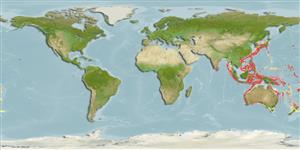Common names from other countries
Environment: milieu / climate zone / depth range / distribution range
Ecología
marino batidemersal; rango de profundidad 140 - 600 m (Ref. 44036). Deep-water
Western Pacific: southern Japan. More recent works report of its occurrence in Taiwan (Ref. 5193), Malaysia (Ref. 5756) and the Chesterfield Islands (Ref. 11897).
Tamaño / Peso / Age
Maturity: Lm ? range ? - ? cm
Max length : 95.0 cm SL macho / no sexado; (Ref. 559); common length : 35.0 cm NG macho / no sexado; (Ref. 27550)
Short description
Claves de identificación | Morfología | Morfometría
Espinas dorsales (total) : 0; Radios blandos dorsales (total) : 8 - 10; Espinas anales: 0. Longest ray of pelvic fin thin, long reaching to or near tip of pectoral fin. Lip of upper jaw thin. Upper jaw with a short band of villiform teeth; lower jaw, palatine, pre vomer and tongue toothless. Body purplish-brown, semi-transparent. Attain 95 cm SL.
Feeds on prawns (Ref. 27550).
Life cycle and mating behavior
Maturities | Reproducción | Spawnings | Egg(s) | Fecundities | Larva
Masuda, H., K. Amaoka, C. Araga, T. Uyeno and T. Yoshino, 1984. The fishes of the Japanese Archipelago. Vol. 1. Tokai University Press, Tokyo, Japan. 437 p. (text). (Ref. 559)
IUCN Red List Status (Ref. 130435)
CITES (Ref. 128078)
Not Evaluated
Threat to humans
Harmless
Human uses
Pesquerías: sin interés
Herramientas
Special reports
Download XML
Fuentes de Internet
Estimates based on models
Preferred temperature (Ref.
115969): 8.1 - 18.9, mean 13.1 (based on 271 cells).
Phylogenetic diversity index (Ref.
82804): PD
50 = 0.5315 [Uniqueness, from 0.5 = low to 2.0 = high].
Bayesian length-weight: a=0.00389 (0.00180 - 0.00842), b=3.12 (2.94 - 3.30), in cm Total Length, based on all LWR estimates for this body shape (Ref.
93245).
Nivel trófico (Ref.
69278): 4.2 ±0.73 se; based on food items.
Fishing Vulnerability (Ref.
59153): High to very high vulnerability (70 of 100).
